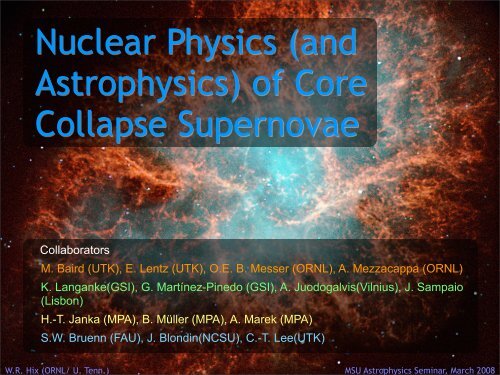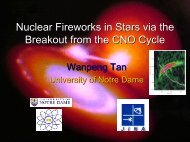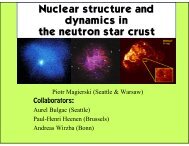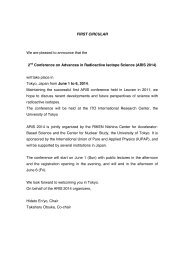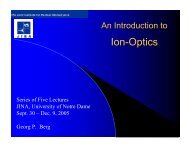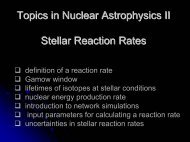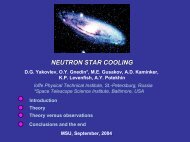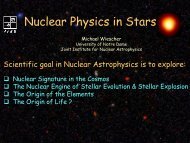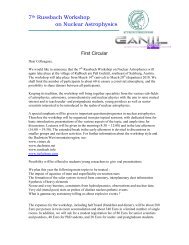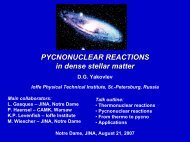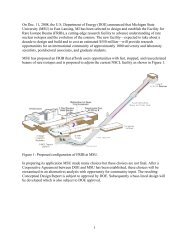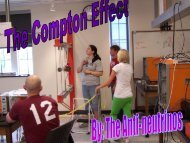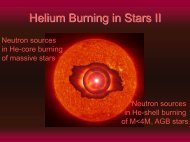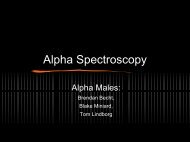Nuclear Physics (and Astrophysics) of Core Collapse Supernovae
Nuclear Physics (and Astrophysics) of Core Collapse Supernovae
Nuclear Physics (and Astrophysics) of Core Collapse Supernovae
You also want an ePaper? Increase the reach of your titles
YUMPU automatically turns print PDFs into web optimized ePapers that Google loves.
W.R. Hix (ORNL/ U. Tenn.) MSU <strong>Astrophysics</strong> Seminar, March 2008<br />
<strong>Nuclear</strong> <strong>Physics</strong> (<strong>and</strong><br />
<strong>Astrophysics</strong>) <strong>of</strong> <strong>Core</strong><br />
<strong>Collapse</strong> <strong>Supernovae</strong><br />
Collaborators<br />
M. Baird (UTK), E. Lentz (UTK), O.E. B. Messer (ORNL), A. Mezzacappa (ORNL)<br />
K. Langanke(GSI), G. Martínez-Pinedo (GSI), A. Juodogalvis(Vilnius), J. Sampaio<br />
(Lisbon)<br />
H.-T. Janka (MPA), B. Müller (MPA), A. Marek (MPA)<br />
S.W. Bruenn (FAU), J. Blondin(NCSU), C.-T. Lee(UTK)
W.R. Hix (ORNL/ U. Tenn.) MSU <strong>Astrophysics</strong> Seminar, March 2008<br />
Microscopic Macroscopic<br />
<strong>Core</strong> <strong>Collapse</strong> <strong>Supernovae</strong> present an interesting<br />
<strong>Nuclear</strong> <strong>Physics</strong> problem in that physics at the<br />
femtometer scale drives (<strong>and</strong> is driven by)<br />
astrophysical processes at the kilometer scale,<br />
leading to explosions that<br />
spread debris over<br />
exameter scales.
W.R. Hix (ORNL/ U. Tenn.) MSU <strong>Astrophysics</strong> Seminar, March 2008<br />
Microscopic Macroscopic<br />
<strong>Core</strong> <strong>Collapse</strong> <strong>Supernovae</strong> present an interesting<br />
<strong>Nuclear</strong> <strong>Physics</strong> problem in that physics at the<br />
femtometer scale drives (<strong>and</strong> is driven by)<br />
astrophysical processes at the kilometer scale,<br />
leading to explosions that<br />
spread debris over<br />
exameter scales.
W.R. Hix (ORNL/ U. Tenn.) MSU <strong>Astrophysics</strong> Seminar, March 2008<br />
Textbook Supernova<br />
ν-Luminosity<br />
Matter Flow<br />
Heating<br />
_ ν e + n → p + e -<br />
ν e + p → n + e +<br />
Shock<br />
_ ν e + n ← p + e -<br />
ν e + p ← n + e +<br />
Cooling<br />
Gain Radius<br />
Proto-Neutron<br />
Star<br />
ν-Spheres
Supernova Nucleosynthesis<br />
W.R. Hix (ORNL/ U. Tenn.) MSU <strong>Astrophysics</strong> Seminar, March 2008
W.R. Hix (ORNL/ U. Tenn.) MSU <strong>Astrophysics</strong> Seminar, March 2008<br />
Examining Microphysics Effects<br />
Spherically symmetric collapse, bounce <strong>and</strong> shock<br />
stall simulations using AGILE-BOLTZTRAN<br />
Fully implicit, multi-group, 4-flavor Boltzmann<br />
neutrino transport<br />
• Most modern neutrino physics, LMSH electron capture rates (Hix et al. 2004,<br />
Langanke et al. 2003) or Bruenn 85 electron capture rates (Bruenn 1985)<br />
• Implicit, spherically symmetric<br />
hydrodynamics with an adaptive<br />
mesh.<br />
• Both general relativistic<br />
(including gravitational redshift)<br />
<strong>and</strong> Newtonian gravity.<br />
Liebendörfer, Messer,<br />
Mezzacappa, Bruenn,<br />
Cardall & Thielemann (2004)<br />
• Modular architecture allows<br />
use <strong>of</strong> multiple realistic equations<br />
<strong>of</strong> state.
W.R. Hix (ORNL/ U. Tenn.) MSU <strong>Astrophysics</strong> Seminar, March 2008<br />
History <strong>of</strong> Captures on Nuclei<br />
Entropy <strong>of</strong> iron core is low<br />
(S/k ~1) so few free<br />
nucleons are present. Thus<br />
e - <strong>and</strong> ν capture on heavy<br />
nuclei via 1 f 7/2 ⇔ 1 f 5/2 GT<br />
transition dominates.<br />
(Bethe,Brown, Applegate & Lattimer 1979)<br />
During collapse, average<br />
mass <strong>of</strong> nuclei increases,<br />
quenching e - capture (at<br />
N=40).<br />
Thermal unblocking <strong>and</strong> first<br />
forbidden were considered<br />
but rates too small.<br />
(Fuller 1982, Cooperstein & Wambach 1984)<br />
Implemented using average<br />
nucleus. Bruenn (1985)
W.R. Hix (ORNL/ U. Tenn.) MSU <strong>Astrophysics</strong> Seminar, March 2008<br />
New e - /ν Capture Rates<br />
Shell Model calculations<br />
are currently limited to<br />
A~65.<br />
Langanke, …, Hix, … (2003)<br />
Langanke et al (2003)<br />
employed a hybrid <strong>of</strong><br />
shell model (SMMC) <strong>and</strong><br />
RPA to calculate a<br />
scattering <strong>of</strong> rates for<br />
A
W.R. Hix (ORNL/ U. Tenn.) MSU <strong>Astrophysics</strong> Seminar, March 2008<br />
New e - /ν Capture Rates<br />
Shell Model calculations<br />
are currently limited to<br />
A~65.<br />
Langanke, …, Hix, … (2003)<br />
Langanke et al (2003)<br />
employed a hybrid <strong>of</strong><br />
shell model (SMMC) <strong>and</strong><br />
RPA to calculate a<br />
scattering <strong>of</strong> rates for<br />
A
The impact <strong>of</strong> EC with stellar mass<br />
15 M 25 M <br />
Higher mass cores have higher initial entropy.<br />
Effects <strong>of</strong> nuclear electron capture are reduced<br />
but comparable (1/2 to 2/3).<br />
W.R. Hix (ORNL/ U. Tenn.) MSU <strong>Astrophysics</strong> Seminar, March 2008
W.R. Hix (ORNL/ U. Tenn.) MSU <strong>Astrophysics</strong> Seminar, March 2008<br />
PNS Convection<br />
Fluid instabilities which<br />
drive convection result<br />
from complete neutrino<br />
radiation-hydrodynamic<br />
problem including<br />
nuclear interactions.<br />
Hix, Messer, Mezzacappa, … 2003<br />
Updated nuclear<br />
e - /ν capture restricts<br />
PNS convection to<br />
smaller, deeper region.
W.R. Hix (ORNL/ U. Tenn.) MSU <strong>Astrophysics</strong> Seminar, March 2008<br />
Changes in Neutrino Emission<br />
ν e burst slightly delayed<br />
<strong>and</strong> prolonged.<br />
Other luminosities<br />
minimally affected (~1%).<br />
Hix, Messer, Mezzacappa, … 2003
W.R. Hix (ORNL/ U. Tenn.) MSU <strong>Astrophysics</strong> Seminar, March 2008<br />
Changes in Neutrino Emission<br />
ν e burst slightly delayed<br />
<strong>and</strong> prolonged.<br />
Other luminosities<br />
minimally affected (~1%).<br />
Mean ν Energy altered:<br />
Hix, Messer, Mezzacappa, … 2003<br />
1-2 MeV during collapse<br />
~1 MeV up to 50ms<br />
after bounce<br />
~.3 MeV at late time
W.R. Hix (ORNL/ U. Tenn.) MSU <strong>Astrophysics</strong> Seminar, March 2008<br />
What Rates are needed?<br />
Change in lepton<br />
abundance<br />
(Y l =Y e +Y ν ) occurs<br />
gradually up to<br />
~3x10 12 g/cm 3 .<br />
By 3x10 12 , rate <strong>of</strong><br />
electron capture<br />
is determined<br />
largely by<br />
blocking.<br />
Y l<br />
,Y e<br />
0.4<br />
0.35<br />
0.3<br />
0.25<br />
N p<br />
*N h<br />
=0.1<br />
N p<br />
*N h<br />
=1.0<br />
N p<br />
*N h<br />
=10.<br />
0.05 M ȯ<br />
Yl<br />
Ye<br />
10 10 10 11 10 12 10 13 10 14<br />
Density (g/cm 3 )
W.R. Hix (ORNL/ U. Tenn.) MSU <strong>Astrophysics</strong> Seminar, March 2008<br />
What Rates are needed?<br />
Change in lepton<br />
abundance<br />
(Y l =Y e +Y ν ) occurs<br />
gradually up to<br />
~3x10 12 g/cm 3 .<br />
By 3x10 12 , rate <strong>of</strong><br />
electron capture<br />
is determined<br />
largely by<br />
blocking.<br />
Y l<br />
,Y e<br />
0.4<br />
0.35<br />
0.3<br />
0.25<br />
N p<br />
*N h<br />
=0.1<br />
N p<br />
*N h<br />
=1.0<br />
N p<br />
*N h<br />
=10.<br />
0.05 M ȯ<br />
Yl<br />
Ye<br />
10 10 10 11 10 12 10 13 10 14<br />
Density (g/cm 3 )
W.R. Hix (ORNL/ U. Tenn.) MSU <strong>Astrophysics</strong> Seminar, March 2008<br />
What Rates are needed?<br />
Change in lepton<br />
abundance<br />
(Y l =Y e +Y ν ) occurs<br />
gradually up to<br />
~3x10 12 g/cm 3 .<br />
By 3x10 12 , rate <strong>of</strong><br />
electron capture<br />
is determined<br />
largely by<br />
blocking.<br />
Average <strong>Nuclear</strong><br />
Mass by 10 12 is<br />
100 or more with<br />
many nuclei<br />
contributing.<br />
Y l<br />
,Y e<br />
A, Z<br />
200<br />
A N p<br />
*N h<br />
=0.1<br />
0.4<br />
N p<br />
*N h<br />
=1.0<br />
N p<br />
*N h<br />
=10.<br />
150<br />
0.35<br />
0.05 M ȯ<br />
100<br />
0.3<br />
50<br />
0.25<br />
Ye<br />
10 10 10 11 density 10 [g/cm 12 ]<br />
10 13 10 14<br />
Density (g/cm 3 )<br />
Yl<br />
0<br />
10 10 10 11 10 12 10 13 10 14<br />
Z
W.R. Hix (ORNL/ U. Tenn.) MSU <strong>Astrophysics</strong> Seminar, March 2008<br />
What Rates are needed?<br />
Change in lepton<br />
abundance<br />
(Y l =Y e +Y ν ) occurs<br />
gradually up to<br />
~3x10 12 g/cm 3 .<br />
By 3x10 12 , rate <strong>of</strong><br />
electron capture<br />
is determined<br />
largely by<br />
blocking.<br />
Average <strong>Nuclear</strong><br />
Mass by 10 12 is<br />
100 or more with<br />
many nuclei<br />
contributing.<br />
Y l<br />
,Y e<br />
A, Z<br />
200<br />
A N p<br />
*N h<br />
=0.1<br />
0.4<br />
N p<br />
*N h<br />
=1.0<br />
N p<br />
*N h<br />
=10.<br />
150<br />
0.35<br />
0.05 M ȯ<br />
100<br />
0.3<br />
50<br />
0.25<br />
Ye<br />
10 10 10 11 density 10 [g/cm 12 ]<br />
10 13 10 14<br />
Density (g/cm 3 )<br />
Yl<br />
0<br />
10 10 10 11 10 12 10 13 10 14<br />
Z
W.R. Hix (ORNL/ U. Tenn.) MSU <strong>Astrophysics</strong> Seminar, March 2008<br />
What Rates are needed?<br />
Change in lepton<br />
abundance<br />
(Y l =Y e +Y ν ) occurs<br />
gradually up to<br />
~3x10 12 g/cm 3 .<br />
By 3x10 12 , rate <strong>of</strong><br />
electron capture<br />
is determined<br />
largely by<br />
blocking.<br />
Average <strong>Nuclear</strong><br />
Mass by 10 12 is<br />
100 or more with<br />
many nuclei<br />
contributing.<br />
Y l<br />
,Y e<br />
A, Z<br />
200<br />
0.4<br />
150<br />
0.35<br />
100<br />
0.3<br />
50<br />
0.25<br />
10 10 10 11 density 10 [g/cm 12 3 ]<br />
10 13 10 14<br />
Density (g/cm 3 )<br />
N p<br />
*N h<br />
=0.1<br />
N p<br />
*N h<br />
=1.0<br />
N p<br />
*N h<br />
=10.<br />
0.05 M ȯ<br />
Yl<br />
Ye<br />
0<br />
10 10 10 11 10 12 10 13 10 14<br />
Need theory for the large number <strong>of</strong><br />
reactions <strong>of</strong> interest <strong>and</strong> experiments<br />
to constrain this theory.<br />
A<br />
Z
W.R. Hix (ORNL/ U. Tenn.) MSU <strong>Astrophysics</strong> Seminar, March 2008<br />
What can RIBs say about e - /ν Capture?<br />
Charge Exchange Reactions,<br />
e.g. (n,p),(d, 2 He),(t, 3 He),<br />
also sample GT+ strength<br />
distribution, providing strong<br />
constraints on structure<br />
models.<br />
Baümer et al. PRC 68, 031303 (2003)<br />
Current Experiments, on<br />
stable nuclei, agree well with<br />
shell model calculations for<br />
A
W.R. Hix (ORNL/ U. Tenn.) MSU <strong>Astrophysics</strong> Seminar, March 2008<br />
Advertisement<br />
New tabulation <strong>of</strong> nuclear electron capture coming<br />
soon.<br />
Improvements include:<br />
✦<br />
Exp<strong>and</strong>ed range <strong>of</strong> nuclei in NSE<br />
✦ Partition functions exceeding 10 GK (Rauscher 2000)<br />
✦ Updated screening prescription in NSE<br />
✦ Screening <strong>of</strong> weak reactions<br />
✦ Exp<strong>and</strong>ed set <strong>of</strong> SMMC/RPA rates (250)<br />
✦<br />
Finely tabulated spectra (.5 MeV)<br />
Sampaio, Juodogalvis, Langanke, Martínez-Pinedo &<br />
Hix (2008) ADNDT, in prep.
W.R. Hix (ORNL/ U. Tenn.) MSU <strong>Astrophysics</strong> Seminar, March 2008<br />
Inelastic Neutrino-Nucleus Scattering<br />
As with electron/neutrino capture, advances in nuclear<br />
structure physics are improving our underst<strong>and</strong>ing <strong>of</strong><br />
other neutrino-nucleus interactions.<br />
While coherent, elastic ν-nucleus scattering has long<br />
been considered, inelastic ν-nucleus scattering (INNS)<br />
has <strong>of</strong>ten been ignored. The exception is Bruenn &<br />
Haxton (1991) which used INNS rate calculated for 56 Fe<br />
at T=0.<br />
Recently, Juodogalvis, Langake, Martinez-Pinedo, Hix,<br />
Dean & Sampaio (2005) calculated INNS for 40 isotopes <strong>of</strong><br />
Mn, Fe, Co & Ni at finite temperature using a<br />
combination <strong>of</strong> shell model <strong>and</strong> RPA. A tabulation <strong>of</strong> NSEaveraged<br />
rates has been produced for use in supernova<br />
simulations.
W.R. Hix (ORNL/ U. Tenn.) MSU <strong>Astrophysics</strong> Seminar, March 2008<br />
Dynamical Effects <strong>of</strong> INNS?<br />
During collapse, INNS works like NES to equilibrate the neutrino<br />
distribution. However there is little effect from this addition.<br />
Müller, Janka (2008),<br />
priv. comm.<br />
After bounce, heating rate just above shock is boosted (2-3x).<br />
However, heating <strong>of</strong> supersonically infalling matter is ineffective,<br />
so dynamics are little effected.
W.R. Hix (ORNL/ U. Tenn.) MSU <strong>Astrophysics</strong> Seminar, March 2008<br />
Observable Effects <strong>of</strong> INNS<br />
Higher energy<br />
tail <strong>of</strong> ν<br />
spectra are<br />
strongly<br />
suppressed<br />
during this<br />
interval.<br />
Langanke, Martínez-Pinedo,<br />
Müller, Janka, Marek, Hix,<br />
Juodagalvis & Sampaio (2007)<br />
Has a surprisingly large<br />
effect on potential<br />
terrestrial ν detectors.
W.R. Hix (ORNL/ U. Tenn.) MSU <strong>Astrophysics</strong> Seminar, March 2008<br />
Summary for <strong>Nuclear</strong> Opacities<br />
Electron <strong>and</strong> neutrino captures on heavy nuclei play<br />
an important role during core collapse, affecting<br />
✦ the initial launching point <strong>of</strong> the shock by up to<br />
20% in mass.<br />
✦ the rate <strong>of</strong> collapse <strong>of</strong> the outer iron core<br />
✦ material gradients in the proto-neutron star.<br />
Inelastic scattering <strong>of</strong> neutrinos <strong>of</strong>f heavy nuclei can<br />
have a large impact on the local heating rate just<br />
above the shock, however, the dynamic impact is<br />
small.<br />
A much larger impact is felt by the high energy tail <strong>of</strong><br />
the supernova neutrino spectra, potentially impacting<br />
terrestrial detectors.
W.R. Hix (ORNL/ U. Tenn.) MSU <strong>Astrophysics</strong> Seminar, March 2008<br />
Role <strong>of</strong> the Equation <strong>of</strong> State<br />
In general, the equation <strong>of</strong> state closes the system<br />
<strong>of</strong> hydrodynamic equations by relating the pressure<br />
to the internal energy (or temperature or entropy),<br />
density <strong>and</strong> composition.<br />
For supernovae, it includes contributions from<br />
photons, degenerate electrons & positrons, <strong>and</strong><br />
nuclei or nuclear matter.<br />
In regions where <strong>Nuclear</strong> Statistical Equilibrium can<br />
be assumed, the supernova EOS also provides the<br />
nuclear composition, usually in the form <strong>of</strong> mass<br />
fractions for free nucleons, alpha particles <strong>and</strong> a<br />
representative heavy nucleus.
W.R. Hix (ORNL/ U. Tenn.) MSU <strong>Astrophysics</strong> Seminar, March 2008<br />
Examining Equations <strong>of</strong> State<br />
✦ LS EoS (Lattimer-Swesty 1991)<br />
• Liquid drop model<br />
• Compressibility – 180 MeV<br />
• Complete EoS - Includes baryon, lepton <strong>and</strong> photon contributions<br />
• Alpha abundance error<br />
✦ STOS EOS (Shen, Toki, Oyamatsu & Sumiyoshi 1998)<br />
• Relativistic mean field theory<br />
• Compressibility – 281 MeV<br />
• Tabular <strong>Nuclear</strong> EoS - Includes only nuclear contributions<br />
✦ Wilson EOS (Mayle & Wilson 1991, McAbee & Wilson 1994)<br />
• Empirical Relation <strong>of</strong> Baron, Cooperstein & Kahana (1985), constrained<br />
by relativistic Brueckner-Hartree-Fock calculations <strong>of</strong> Muther, Prakash<br />
& Ainsworth (1987).<br />
• Compressibility – 200 MeV<br />
• Includes Pions at high density constrained by comparison <strong>of</strong> simulations<br />
<strong>of</strong> Pion production in heavy ion collisions with experimental data.<br />
• Tabular Complete EoS
W.R. Hix (ORNL/ U. Tenn.) MSU <strong>Astrophysics</strong> Seminar, March 2008<br />
Pressure<br />
for fixed thermodynamic conditions<br />
near bounce<br />
Baird, Lentz, Hix, Messer & Mezzacappa, in prep.<br />
Differences limited to nuclear matter.<br />
At lower density, electrons dominate pressure.
W.R. Hix (ORNL/ U. Tenn.) MSU <strong>Astrophysics</strong> Seminar, March 2008<br />
Internal energy<br />
for fixed thermodynamic conditions<br />
near bounce<br />
Baird, Lentz, Hix, Messer & Mezzacappa, in prep.<br />
Moderate differences, with STOS having higher<br />
internal energies in the region <strong>of</strong> forming shock.
W.R. Hix (ORNL/ U. Tenn.) MSU <strong>Astrophysics</strong> Seminar, March 2008<br />
Entropy<br />
for fixed thermodynamic conditions<br />
near bounce<br />
Baird, Lentz, Hix, Messer & Mezzacappa, in prep.<br />
Noticable differences at center, even larger differences at<br />
lower density.<br />
Entropy is dominated by the nuclear contribution.
W.R. Hix (ORNL/ U. Tenn.) MSU <strong>Astrophysics</strong> Seminar, March 2008<br />
Composition<br />
Baird, Lentz, Hix, Messer<br />
& Mezzacappa, in prep.<br />
Composition <strong>of</strong> unshocked matter shows large differences.
W.R. Hix (ORNL/ U. Tenn.) MSU <strong>Astrophysics</strong> Seminar, March 2008<br />
Composition after bounce<br />
Baird, Lentz, Hix, Messer<br />
& Mezzacappa, in prep.<br />
Shocked compositions similar except Wilson near<br />
phase transition
W.R. Hix (ORNL/ U. Tenn.) MSU <strong>Astrophysics</strong> Seminar, March 2008<br />
Self-consistent Simulations<br />
Examined the<br />
impact <strong>of</strong> the EOS<br />
using Agile-Boltztran<br />
GR simulations <strong>of</strong><br />
15 M progenitor.<br />
STOS<br />
LS<br />
Wilson<br />
10 2 Time After Bounce [s]<br />
Differences persist<br />
in spherically<br />
symmetric models<br />
for more than 200<br />
ms after bounce.<br />
Radius [km]<br />
Baird, Lentz, Hix, Messer & Mezzacappa, in prep.<br />
10 1<br />
0 50 100 150 200<br />
STOS: Shock launches<br />
slowly <strong>and</strong> peaks near 50<br />
ms with smallest shock<br />
stall radius.<br />
Wilson: Shock launches<br />
strongly, peaking near 150<br />
ms with largest shock stall<br />
radius.
W.R. Hix (ORNL/ U. Tenn.) MSU <strong>Astrophysics</strong> Seminar, March 2008<br />
EOS Comparison w/<strong>Nuclear</strong> EC<br />
Y e<br />
(Electron Fraction)<br />
Entropy per baryon<br />
Density (g cm !3 )<br />
0.55<br />
0.45<br />
0.35<br />
0.25<br />
10 8<br />
5<br />
4<br />
3<br />
2<br />
1<br />
10 14<br />
10 12<br />
10 10<br />
1 x 105<br />
STOS<br />
LS<br />
Wilson<br />
Velocity (km/s)<br />
0<br />
Baird, Lentz, Hix, Messer & Mezzacappa, in prep.<br />
!1<br />
0 0.2 0.4 0.6 0.8 1 1.2 1.4 1.6<br />
Enclosed Mass<br />
At bounce, Wilson shows larger core <strong>and</strong> faster collapsing outer core.
W.R. Hix (ORNL/ U. Tenn.) MSU <strong>Astrophysics</strong> Seminar, March 2008<br />
EOS Comparison w/<strong>Nuclear</strong> EC<br />
e<br />
(Electron Fraction)<br />
Y (Electron Fraction)<br />
e<br />
Entropy per baryon<br />
Entropy per baryon<br />
Density Density (g (g cm cm !3 !3 ) )<br />
0.55<br />
0.6<br />
0.5<br />
0.45<br />
0.4<br />
0.35<br />
0.25<br />
0.1<br />
145<br />
12<br />
4<br />
10<br />
83<br />
62<br />
41<br />
2<br />
0<br />
10 10 14 14<br />
10 10 12 12<br />
10 10 10 10<br />
10 10 88<br />
1 x 105 105<br />
STOS<br />
LS L!S<br />
Wilson STOS<br />
Wilson<br />
100 ms after bounce<br />
Velocity (km/s)<br />
Velocity (km/s)<br />
0<br />
Baird, Lentz, Hix, Messer & Mezzacappa, in prep.<br />
!1<br />
0 0.2 0.4 0.6 0.8 1 1.2 1.4 1.6<br />
Enclosed Mass<br />
At bounce, Wilson shows larger core <strong>and</strong> faster collapsing outer core.<br />
After bounce, Wilson <strong>and</strong> STOS show different Ye gradients.
W.R. Hix (ORNL/ U. Tenn.) MSU <strong>Astrophysics</strong> Seminar, March 2008<br />
EOS Comparison w/proton EC<br />
Y e<br />
(Electron Fraction)<br />
Entropy per baryon<br />
Density (g cm !3 )<br />
0.5<br />
0.4<br />
0.3<br />
0.2<br />
6<br />
4<br />
2<br />
0<br />
10 14<br />
10 12<br />
10 10<br />
10 8<br />
5 x 104<br />
STOS<br />
LS<br />
Wilson<br />
Velocity (km/s)<br />
0<br />
!5<br />
Baird, Lentz, Hix, Messer & Mezzacappa, in prep.<br />
!10<br />
0 0.2 0.4 0.6 0.8 1 1.2 1.4 1.6<br />
Enclosed Mass<br />
At bounce, shock location similar, but core Ye gradient stronger.
W.R. Hix (ORNL/ U. Tenn.) MSU <strong>Astrophysics</strong> Seminar, March 2008<br />
EOS Comparison w/proton EC<br />
Y (Electron e Fraction)<br />
Entropy per per baryon<br />
Density (g (g cm !3 !3 ) )<br />
0.6 0.5<br />
0.5<br />
0.4<br />
0.4<br />
0.3<br />
0.3<br />
0.2<br />
0.1 0.2<br />
126<br />
10<br />
84<br />
6<br />
42<br />
2<br />
00<br />
10 10 14 14<br />
10 10 12 12<br />
10 10 10 10<br />
10 10 8 8<br />
15 x x 105 104<br />
L!S<br />
STOS<br />
WIlson LS<br />
Wilson<br />
100 ms after bounce<br />
Velocity (km/s)<br />
0<br />
0<br />
!5<br />
Baird, Lentz, Hix, Messer & Mezzacappa, in prep.<br />
!10<br />
00 0.2 0.4 0.6 0.8 1 1.2 1.4 1.6<br />
Enclosed Mass<br />
At bounce, shock location similar, but core Ye gradient stronger.<br />
After bounce, Wilson <strong>and</strong> STOS still show different Ye gradients.
W.R. Hix (ORNL/ U. Tenn.) MSU <strong>Astrophysics</strong> Seminar, March 2008<br />
A Closer look at bounce with Wilson EoS…<br />
Lower Pressure<br />
results in higher<br />
bounce density.<br />
Ye decreases rapidly<br />
in the central core<br />
as Pions become<br />
important.<br />
Pions reduce proton<br />
chemical potential<br />
shifting detailed<br />
balance away from<br />
electrons <strong>and</strong> toward<br />
neutrinos.<br />
Baird, Lentz, Hix, Messer & Mezzacappa,<br />
in prep.
W.R. Hix (ORNL/ U. Tenn.) MSU <strong>Astrophysics</strong> Seminar, March 2008<br />
Interplay <strong>of</strong> EOS <strong>and</strong> <strong>Nuclear</strong> Electron Capture<br />
Baird, Lentz, Hix, Messer & Mezzacappa, in prep.<br />
Composition provided by the EOS impacts relative<br />
strength <strong>of</strong> opacities. Thus statements about<br />
importance <strong>of</strong> opacities must be re-examined in<br />
light <strong>of</strong> progress on the EOS.
W.R. Hix (ORNL/ U. Tenn.) MSU <strong>Astrophysics</strong> Seminar, March 2008<br />
EOS effects<br />
Equations <strong>of</strong> State play a large role in collapse<br />
<strong>and</strong> drives the physics involved in post bounce<br />
evolution.<br />
In spite <strong>of</strong> relatively small differences in the<br />
nuclear matter regime:<br />
•Initial proto-neutron star size different by<br />
almost 20%<br />
•20% differences in shock location after 200 ms<br />
•Altered lepton <strong>and</strong> entropy gradients<br />
Effects <strong>of</strong> EOS not limited to pressure but also<br />
include composition <strong>and</strong> therefore opacities.
W.R. Hix (ORNL/ U. Tenn.) MSU <strong>Astrophysics</strong> Seminar, March 2008<br />
Multi-<strong>Physics</strong> Supernova Models<br />
CHIMERA Building Blocks<br />
• “RbR-Plus” MGFLD Neutrino<br />
Transport<br />
• PPM Hydrodynamics<br />
• Lattimer-Swesty EOS<br />
• <strong>Nuclear</strong> (α) Network<br />
• Newtonian Gravity with<br />
Spherical GR Corrections<br />
• Neutrino Emissivities/Opacities<br />
St<strong>and</strong>ard (Bruenn 1985)<br />
Elastic Scattering on Nucleons<br />
Nucleon–Nucleon Bremsstrahlung<br />
• Run for postbounce times > 400 ms.<br />
• Run on a 180 degree grid.<br />
Ray-by-Ray Approximation<br />
Radial transport allowed.<br />
Lateral transport suppressed.<br />
Cast:<br />
Bruenn, Blondin, Hix,<br />
Marronetti, Messer,<br />
Mezzacappa, Lentz,<br />
Budiardja, Lee,<br />
Yakunin, …
W.R. Hix (ORNL/ U. Tenn.) MSU <strong>Astrophysics</strong> Seminar, March 2008<br />
2D Results<br />
20 M GR<br />
Resolution<br />
r,θ: 256, 256<br />
ν energy: 20<br />
Instability behind the shock distorts <strong>and</strong> exp<strong>and</strong>s the shock,<br />
increasing neutrino heating.<br />
Explosion takes several hundred ms after bounce to develop.
W.R. Hix (ORNL/ U. Tenn.) MSU <strong>Astrophysics</strong> Seminar, March 2008<br />
Anatomy <strong>of</strong> Explosion<br />
Radius (km)<br />
20 M GR<br />
Resolution<br />
r,θ: 256, 256<br />
ν energy: 20<br />
Avg Atomic Mass<br />
Time (s)
W.R. Hix (ORNL/ U. Tenn.) MSU <strong>Astrophysics</strong> Seminar, March 2008<br />
Anatomy <strong>of</strong> Explosion<br />
Si Layer<br />
O Layer<br />
Radius (km)<br />
Iron<br />
<strong>Core</strong><br />
20 M GR<br />
Resolution<br />
r,θ: 256, 256<br />
ν energy: 20<br />
Avg Atomic Mass<br />
Time (s)
W.R. Hix (ORNL/ U. Tenn.) MSU <strong>Astrophysics</strong> Seminar, March 2008<br />
Anatomy <strong>of</strong> Explosion<br />
Si Layer<br />
O Layer<br />
Radius (km)<br />
Iron<br />
<strong>Core</strong><br />
20 M GR<br />
Resolution<br />
r,θ: 256, 256<br />
ν energy: 20<br />
Avg Atomic Mass<br />
Time (s)
W.R. Hix (ORNL/ U. Tenn.) MSU <strong>Astrophysics</strong> Seminar, March 2008<br />
Anatomy <strong>of</strong> Explosion<br />
Si Layer<br />
O Layer<br />
Shock<br />
Radius (km)<br />
Iron<br />
<strong>Core</strong><br />
20 M GR<br />
Resolution<br />
r,θ: 256, 256<br />
ν energy: 20<br />
Avg Atomic Mass<br />
Time (s)
W.R. Hix (ORNL/ U. Tenn.) MSU <strong>Astrophysics</strong> Seminar, March 2008<br />
Effects <strong>of</strong> <strong>Nuclear</strong> Burning?<br />
11 M GR<br />
Resolution<br />
r,θ: 256, 128<br />
ν energy: 20
W.R. Hix (ORNL/ U. Tenn.) MSU <strong>Astrophysics</strong> Seminar, March 2008<br />
Effects <strong>of</strong> <strong>Nuclear</strong> Burning?<br />
11 M GR<br />
Resolution<br />
r,θ: 256, 128<br />
ν energy: 20<br />
Heat near the shock from O/Si<br />
burning helps boosts shock.
W.R. Hix (ORNL/ U. Tenn.) MSU <strong>Astrophysics</strong> Seminar, March 2008<br />
Need for 3D?<br />
Stationary Accretion Shock Instability (SASI)<br />
Shock wave unstable to nonradial perturbations.<br />
Blondin, Mezzacappa<br />
& DeMarino (2003)<br />
• SASI has axisymmetric <strong>and</strong> nonaxisymmetric modes that are<br />
both linearly unstable!<br />
– Blondin <strong>and</strong> Mezzacappa, Ap.J. 642, 401 (2006)<br />
– Blondin <strong>and</strong> Shaw, Ap.J. 656, 366 (2007)
W.R. Hix (ORNL/ U. Tenn.) MSU <strong>Astrophysics</strong> Seminar, March 2008<br />
Need for 3D?<br />
Stationary Accretion Shock Instability (SASI)<br />
Shock wave unstable to nonradial perturbations.<br />
Power in m=1 mode.<br />
Blondin, Mezzacappa<br />
& DeMarino (2003)<br />
Power in l=1 mode.<br />
• SASI has axisymmetric <strong>and</strong> nonaxisymmetric modes that are<br />
both linearly unstable!<br />
– Blondin <strong>and</strong> Mezzacappa, Ap.J. 642, 401 (2006)<br />
– Blondin <strong>and</strong> Shaw, Ap.J. 656, 366 (2007)
W.R. Hix (ORNL/ U. Tenn.) MSU <strong>Astrophysics</strong> Seminar, March 2008<br />
Summary for RBR models<br />
Multi-group transport, increased run<br />
times, improved neutrino emissivities &<br />
opacities, <strong>and</strong> the inclusion <strong>of</strong> nuclear<br />
burning(?) are all critical.<br />
With self-consistent explosions, we can<br />
examine use nucleosynthesis to further<br />
constrain models.<br />
3D may be necessary as hydro studies<br />
suggest that the outcomes in 3D may be<br />
fundamentally different than 2D.<br />
Impact <strong>of</strong> magnetic fields remains<br />
to be seen.
W.R. Hix (ORNL/ U. Tenn.) MSU <strong>Astrophysics</strong> Seminar, March 2008<br />
Summary<br />
1) <strong>Nuclear</strong> <strong>Physics</strong> provides vital ingredients, in<br />
the form <strong>of</strong> neutrino opacities, the equation <strong>of</strong><br />
state <strong>and</strong> reaction rates relevant for<br />
nucleosynthesis, for supernova simulations.<br />
2) The interrelation <strong>of</strong> these microphysical<br />
ingredients, both with each other, <strong>and</strong> the<br />
macroscopic astrophysical environment makes<br />
ongoing examinations important.<br />
3) We are entering a very interesting period in<br />
core collapse supernova simulation.


